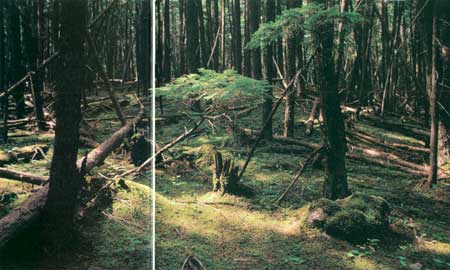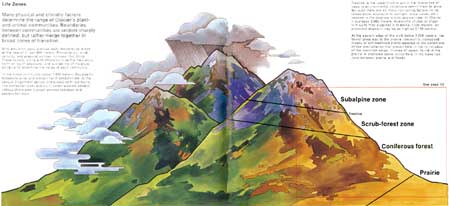
The Forests of Glacier
From the lush redcedar-hemlock forest in the McDonald Valley to the
subalpine fir, whitebark pine, and Englemann spruce struggling for
existence near treeline, the forests of Glacier reflect the conditions
of temperature, exposure, soil, and drainage prevailing; and each forest
has its characteristic association of understory trees and shrubs,
herbaceous ground cover, and vertebrate and invertebrate animal
life.
|

Life Zones
Many physical and climatic factors determine the range of Glacier's
plant-and-animal communities. Boundaries between communities are seldom
sharply defined, but rather merge together in broad zones of
transition.
With elevation gain, average daily temperature drops at the rate of
5° per 900 meters. Precipitation, wind velocity, and evaporation
loss increase. Soil thins. These factors, along with others such as fire
frequency, north or south exposure, and availability of moisture,
combine to determine the range of each community.
In the forest community below 1,800 meters, Douglas-fir, lodgepole pine,
and western larch predominate. In the valleys, Engelmann spruce and
subalpine fir are found. The somewhat lower and much better watered
western valleys of the park support western redcedar and western
hemlock.
Treeline is the upper limit to which the tolerances of trees to
environmental conditions permit them to grow. Because there are so many
controlling factors (wind, temperature, exposure to sunlight, snow
cover, etc.) treeline in the diagram is only approximate. In Glacier it
averages 2,000 meters. Avalanche chutes or sheer cliff walls may
suppress it to below 1,500 meters: on protected slopes it may be as high
as 2,150 meters.
At the eastern edge of the park below 1,200 meters, the forest gives way
to the prairie community, composed mostly of soft-stemmed plants adapted
to the conditions of low precipitation that prevail here in the
rainshadow of the mountain range. Clumps of aspen, found in the prairie
in sheltered spots, occur here in the transition zone between prairie
and forest.
(click on above image for an enlargement in a new window)
|

|

|
|







